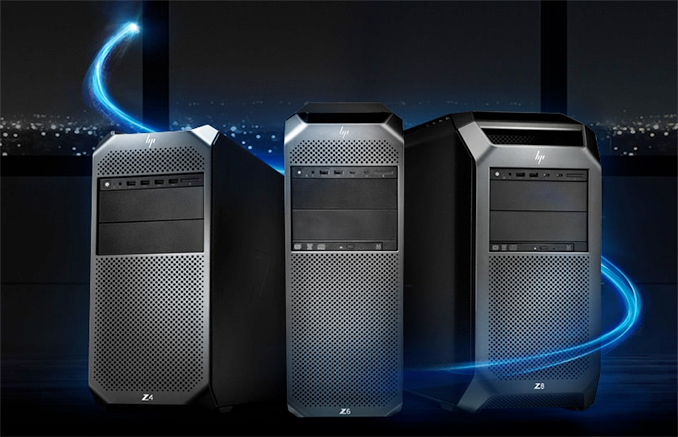HP’s Cascade Lake Z6 & Z8 Xeon Scalable Workstations with Up to 6 TB Optane
by Anton Shilov on April 10, 2019 12:00 PM EST- Posted in
- Workstation
- Intel
- HP
- HP Z8
- Xeon Scalable
- Optane DCPMM
- HP Z6

Being one of the world’s largest workstation supplier, HP is among the first to adopt new CPUs, GPUs, and other technologies that can speed up professional workloads. This week the company introduced its updated Z6 G4 and Z8 G4 machines with Intel’s second generation Xeon Scalable processors and Intel’s Optane DC Persistent Memory.
The new HP Z6 and HP Z8 machines belong to HP’s fourth-generation Z6/Z8 workstations and therefore generally resemble their predecessors introduced about two years ago. The Z6 G4 is HP’s compact dual-processor workstation that offers up to 48 cores and up to 384 GB of memory, whereas the Z8 G4 is the company’s range-topping dual-processor workstation that provides up to 56 cores along with maximum expandability possible.
The key difference between the new fourth-gen HP Z6/Z8 and the original machines is update to Intel’s latest Xeon Scalable Cascade Lake processors with up to 28 physical cores per socket, supporting VNNI instructions beneficial for workloads that use neural networks (think AI, ML, etc.) as well as Intel’s Optane DC Persistent Memory Modules enabling to bring large datasets closer to the CPUs (think AI, ML, VFX, etc.). Meanwhile, workstations with Intel’s Optane DCPMM will be available sometime sometime later.
Other features and capabilities of the new HP Z6/Z8 machines are similar to their original versions. The most advanced models of the Z8 will carry up to three professional graphics cards (up to NVIDIA’s Quadro RTX 6000 advertised, but probably HP will offer options from AMD as well), up to 24 DDR4 memory modules, multiple SSDs (including Optane SSDs, HP’s Z Turbo Drive PCIe SSDs, SEDs, etc.), numerous 3.5-inch HDDs, an ODD vast network connectivity options (including GbE, 10 GbE connectors, 802.11ac Wi-Fi), a Thunderbolt 3 controller, advanced security (such as HP’s proprietary SureStart as well as TPM 2.0 module, etc.), and so on.
Since the new HP Z6/Z8 G4 workstations will come in the same chassis as their G4 predecessors, expect them to use the same robust cooling system. The latter will be needed as Intel’s Xeon Scalable chips go up to 205W TDP each and Intel’s Optane DCPMM are up to 18W per module.
HP’s new Z6/Z8 G4 machines will be available shortly, whereas workstations with Optane DCPMMs will ship later. The HP Z6 G4 starts at $2,372, whereas the HP Z8 G4 starts at $2,981. Obviously, once fully equipped, these systems will cost considerably more.
Related Reading
- HP Updates Z8 Workstations: Up to 56 Cores, 3 TB RAM, 9 PCIe Slots, 1700W
- HP Expands Commercial VR Strategy: Z VR Backpack and Immersion Centers
- HP Z2 Mini G3 Announced: Miniature Professional Workstation with Xeon and Quadro
- HP Updates The Z240 Workstation With The Core i7-6700K
Source: HP










6 Comments
View All Comments
duploxxx - Wednesday, April 10, 2019 - link
wow another innovating OEM refresh.... amazing just replace the CPUthe same bullshit 3 * RTX in a dual socket environment.... just copy paste Dell and you have the same announcement.
IGTrading - Friday, April 12, 2019 - link
While AMD EPYC and EPYC 2 are available, it makes no sense in buying anything powered by Intel, unless the code used has a particular handicap and can't run well on anything but Intel and it is so badly written that it can be optimised for AMD :)No really, for 2019, the Xeon makes no sense in most use scenarios.
keistq - Monday, April 15, 2019 - link
Please check availability and prices.AMD 24 Core EPYC 7451 ~ £2,100 - Dual 2x Benchmark 28957
Intel 20 Core 6138 ~ £2,000.00 - Dual 2x Benchmark 33989
I would go for Intel. Cheaper and higher benchmark. And I believe bulk buyers get even better discounts.
oklukar - Monday, April 15, 2019 - link
It all depends on the benchmark and the type of applications the processor will be targeted for. :)You just can't cherry-pick a single benchmark and call the Xeon 6138 the absolute winner. ;)
keistq - Wednesday, April 17, 2019 - link
No, but this is just my story why I decided against EPYC and took 6138. Telling everybody that EPYC is "the best thing since sliced bread" is totally misleading. EPYC is not cheap. It is not even cheaper. And they are sparse.KellyCollins - Sunday, July 25, 2021 - link
You can post the link of your mobile application and ask people to install it. If they find it good, they will give a good feedback and otherwise you will have to improve your application and get <a href="https://www.we-heart.com/2021/05/26/why-do-student... writer</a> services for students. I think this will work very well if you want to take feedbacks.